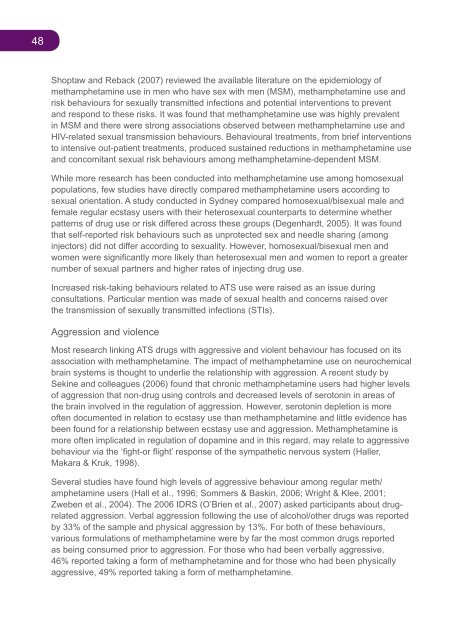National Amphetamine-Type Stimulant Strategy Background Paper
National Amphetamine-Type Stimulant Strategy Background Paper
National Amphetamine-Type Stimulant Strategy Background Paper
Create successful ePaper yourself
Turn your PDF publications into a flip-book with our unique Google optimized e-Paper software.
48<br />
Shoptaw and Reback (2007) reviewed the available literature on the epidemiology of<br />
methamphetamine use in men who have sex with men (MSM), methamphetamine use and<br />
risk behaviours for sexually transmitted infections and potential interventions to prevent<br />
and respond to these risks. It was found that methamphetamine use was highly prevalent<br />
in MSM and there were strong associations observed between methamphetamine use and<br />
HIV-related sexual transmission behaviours. Behavioural treatments, from brief interventions<br />
to intensive out-patient treatments, produced sustained reductions in methamphetamine use<br />
and concomitant sexual risk behaviours among methamphetamine-dependent MSM.<br />
While more research has been conducted into methamphetamine use among homosexual<br />
populations, few studies have directly compared methamphetamine users according to<br />
sexual orientation. A study conducted in Sydney compared homosexual/bisexual male and<br />
female regular ecstasy users with their heterosexual counterparts to determine whether<br />
patterns of drug use or risk differed across these groups (Degenhardt, 2005). It was found<br />
that self-reported risk behaviours such as unprotected sex and needle sharing (among<br />
injectors) did not differ according to sexuality. However, homosexual/bisexual men and<br />
women were significantly more likely than heterosexual men and women to report a greater<br />
number of sexual partners and higher rates of injecting drug use.<br />
Increased risk-taking behaviours related to ATS use were raised as an issue during<br />
consultations. Particular mention was made of sexual health and concerns raised over<br />
the transmission of sexually transmitted infections (STIs).<br />
Aggression and violence<br />
Most research linking ATS drugs with aggressive and violent behaviour has focused on its<br />
association with methamphetamine. The impact of methamphetamine use on neurochemical<br />
brain systems is thought to underlie the relationship with aggression. A recent study by<br />
Sekine and colleagues (2006) found that chronic methamphetamine users had higher levels<br />
of aggression that non-drug using controls and decreased levels of serotonin in areas of<br />
the brain involved in the regulation of aggression. However, serotonin depletion is more<br />
often documented in relation to ecstasy use than methamphetamine and little evidence has<br />
been found for a relationship between ecstasy use and aggression. Methamphetamine is<br />
more often implicated in regulation of dopamine and in this regard, may relate to aggressive<br />
behaviour via the ‘fight-or flight’ response of the sympathetic nervous system (Haller,<br />
Makara & Kruk, 1998).<br />
Several studies have found high levels of aggressive behaviour among regular meth/<br />
amphetamine users (Hall et al., 1996; Sommers & Baskin, 2006; Wright & Klee, 2001;<br />
Zweben et al., 2004). The 2006 IDRS (O’Brien et al., 2007) asked participants about drugrelated<br />
aggression. Verbal aggression following the use of alcohol/other drugs was reported<br />
by 33% of the sample and physical aggression by 13%. For both of these behaviours,<br />
various formulations of methamphetamine were by far the most common drugs reported<br />
as being consumed prior to aggression. For those who had been verbally aggressive,<br />
46% reported taking a form of methamphetamine and for those who had been physically<br />
aggressive, 49% reported taking a form of methamphetamine.

















